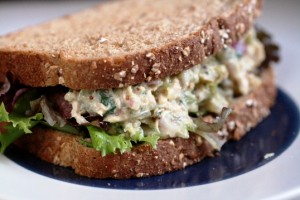

 Calcium and vitamin D are essential for strong, healthy bones—vitamin D is essential for optimum calcium absorption in the small intestine. Recommended calcium levels are 1000 mg per day, 1200 mg if you are over 50 years old. Take a vitamin D and calcium supplement if you don’t get enough of these nutrients from your diet.
Calcium and vitamin D are essential for strong, healthy bones—vitamin D is essential for optimum calcium absorption in the small intestine. Recommended calcium levels are 1000 mg per day, 1200 mg if you are over 50 years old. Take a vitamin D and calcium supplement if you don’t get enough of these nutrients from your diet.
Great sources of calcium include:
 Protein gives us the energy to get up and go—and keep going. Protein in food is broken down into the 20 amino acids that are the body’s basic building blocks for growth and energy, and essential for maintaining cells, tissues and organs. A lack of protein in our diet can slow growth, reduce muscle mass, lower immunity, and weaken the heart and respiratory system. Protein is particularly important for children, whose bodies are growing and changing daily.
Protein gives us the energy to get up and go—and keep going. Protein in food is broken down into the 20 amino acids that are the body’s basic building blocks for growth and energy, and essential for maintaining cells, tissues and organs. A lack of protein in our diet can slow growth, reduce muscle mass, lower immunity, and weaken the heart and respiratory system. Protein is particularly important for children, whose bodies are growing and changing daily.
Here are some guidelines for including protein in your healthy diet:
Try different types of protein. Whether or not you are a vegetarian, trying different protein sources—such as beans, nuts, seeds, peas, tofu and soy products—will open up new options for healthy mealtimes.
Downsize your portions of protein. Most people in the U.S. eat too much protein. Try to move away from protein being the center of your meal. Focus on equal servings of protein, whole grains, and vegetables.
Focus on quality sources of protein, like fresh fish, chicken or turkey, tofu, eggs, beans or nuts. When you are having meat, chicken, or turkey, buy meat that is free of hormones and antibiotics.
Complete, incomplete and complementary proteins
- A complete protein source—from animal proteins such as meat, poultry, fish, milk, cheese and eggs—provides all of the essential amino acids.
- An incomplete protein—from vegetable proteins like grains, legumes, nuts, seeds and beans—is low in one or more essential amino acids.
- Complementary proteins are two or more incomplete protein sources that together provide all of the essential amino acids your body needs. For example, rice and dry beans are each incomplete proteins, but together they provide all of the essential amino acids.
- Do complementary proteins need to be eaten in the same meal? Research shows that your body can combine complementary proteins that are eaten within the same day.
- Why are complete and complementary proteins important? Complete and complementary proteins that provide all of the essential amino acids will fill you up longer than carbohydrates because they break down more slowly in the digestive process.
 Choose healthy carbohydrates and fiber sources, especially whole grains, for long lasting energy. In addition to being delicious and satisfying, whole grains are rich in phytochemicals and antioxidants, which help to protect against coronary heart disease, certain cancers, and diabetes. Studies have shown people who eat more whole grains tend to have a healthier heart.
Choose healthy carbohydrates and fiber sources, especially whole grains, for long lasting energy. In addition to being delicious and satisfying, whole grains are rich in phytochemicals and antioxidants, which help to protect against coronary heart disease, certain cancers, and diabetes. Studies have shown people who eat more whole grains tend to have a healthier heart.
A quick definition of healthy carbs and unhealthy carbs
Healthy carbs (sometimes known as good carbs) include whole grains, beans, fruits, and vegetables. Healthy carbs are digested slowly, helping you feel full longer and keeping blood sugar and insulin levels stable.
Unhealthy carbs (or bad carbs) are foods such as white flour, refined sugar and white rice that have been stripped of all bran, fiber and nutrients. Unhealthy carbs digest quickly and cause spikes in blood sugar levels and energy.
Avoid: Refined grains such as breads, pastas, and breakfast cereals that are not whole grain.
 To set yourself up for success, think about planning a healthy diet as a number of small, manageable steps rather than one big drastic change. If you approach the changes gradually and with commitment, you will have a healthy diet sooner than you think.
To set yourself up for success, think about planning a healthy diet as a number of small, manageable steps rather than one big drastic change. If you approach the changes gradually and with commitment, you will have a healthy diet sooner than you think.
Think of exercise as a food group in your diet.
Find something active that you like to do and add it to your day, just like you would add healthy greens, blueberries or salmon. The benefits of lifelong exercise are abundant and regular exercise may even motivate you to make healthy food choices a habit.